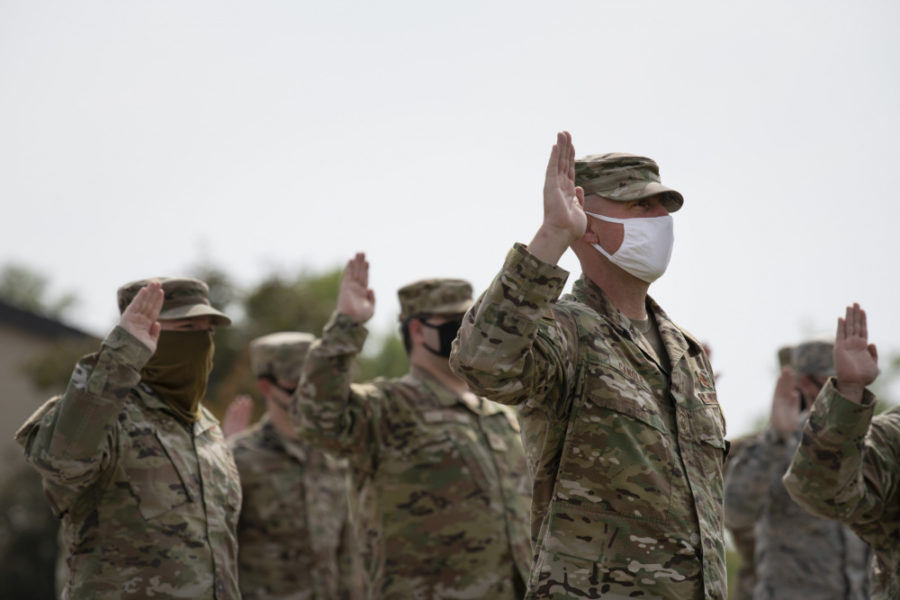Through its first year of existence, the U.S. Space Force was focused on the “macro”—developing the overall structure by which the entirely new service would be organized. Now, as it heads into Year 2, USSF will seek to “actually operationalize” that new structure, said Col. Matthew S. Cantore, commander of Space Delta 2.
Speaking at an Air and Space Warfighters in Action event hosted by the Air Force Association on June 3, Cantore and Chief Master Sgt. April L. Brittain, senior enlisted leader from Space Delta 2, broke down how that new structure differs from the traditional Air Force one and how it will continue to evolve in 2022 and beyond.
With both Cantore and Brittain coming from an Air Force background, they both “bleed blue internally,” Cantore joked early on in Thursday’s event, and they acknowledged the tight bond between the Air and Space Forces. But in the coming years, that blue “is turning to a dark black” as the composition of the Space Force changes.
Specifically, interservice transfers from the Army and Navy are expected to increase in 2022 and 2023, Cantore said, and as those troops come on board, Space Force culture will change.
“We’re excited about that, and I think that’s going to make us stronger,” Cantore said. “We talk about diversity in a lot of ways—that diversity coming from the other services is going to force us maybe a little bit out of our traditional Air Force comfort zone, but this is not the Air Force as a service, it’s a new service, and so we’re finding our way.”
A New Way to Operate
Compared to the Air Force, the Space Force’s new structure of deltas and garrisons has fewer tiers, Cantore explained.
“We have gotten rid of the numbered air force echelon, and we have taken the wing and the group echelons, which we all knew and loved for many years, and we’ve pushed those together, smashed them, and then broken them out,” Cantore said. “So we’ve taken the base operating support, all that combat service support functions, and we’ve taken those and put those into a garrison, which is so critical to support the mission, and now we have the delta, which is singularly focused on the operational mission that we’ve been assigned.”
With fewer levels of command and a smaller force overall, training for the Space Force will have to be different and more all-encompassing, Cantore said.
“As we get ready for significant events, we prepare, we do large scale exercises, but that’s not the norm on a day-to-day framework,” Cantore said. “And so our training, I believe, needs to move to the evolution where it is holistic and enterprise-level.”
The delta, not the squadron, is the “presented force” for the Space Force. And compared to the size of Air Force wings and groups, deltas are small, at least when it comes to personnel.
“I think total, when I was an ops group commander, I started with about 2,000 people, if you add in all the contractors, all the civilians. … Now we’re sitting about 400, 450 total when we add everything together,” Cantore said.
Understanding a Congested Domain
In addition to bringing in new people, Cantore said he expects new systems to come online in 2022 that will expand Space Delta 2’s capabilities and responsibilities.
“[Personnel] numbers wise, you don’t really see a lot of growth here directly in Space Delta 2, but there’s so much going on from a systems standpoint going forward,” Cantore said. “Where you are going to see a lot of growth, I believe, is in the satellite communications arena.”
As part of its operational mission, Space Delta 2 is tasked with tracking thousands of satellites, rockets, and pieces of debris in orbit, and as the unit gets up to date and tracks everything that is already out there, hundreds of more payloads are being added—Cantore noted there have already been more payloads launched into orbit in the first five months of 2021 than there were in all of 2020.
Beyond just tracking those objects, Cantore said Space Delta 2’s goal is to synthesize all the data and collaborate across other Deltas, as well as other services, allies, and commercial partners, to formulate a better understanding of what it all means.
“Understanding what goes on in the domain is the foundation of everything that has to happen going forward, and so we take that very seriously,” Cantore said. “It is certainly not without challenges. This growth that we’re seeing right now—that we have no expectation is going to slow down—it’s going to continue. It’s certainly pushing us to develop and upgrade our capabilities so that we can stay one step ahead of what is becoming a more and more congested domain.”
While still fulfilling that mission, though, the service must also continue to develop its new structure and culture. And developments along that front are expected in the coming months—Brittain said during the same event that USSF is “expecting to release” its new ranks and insignias “hopefully in the June timeframe.”
